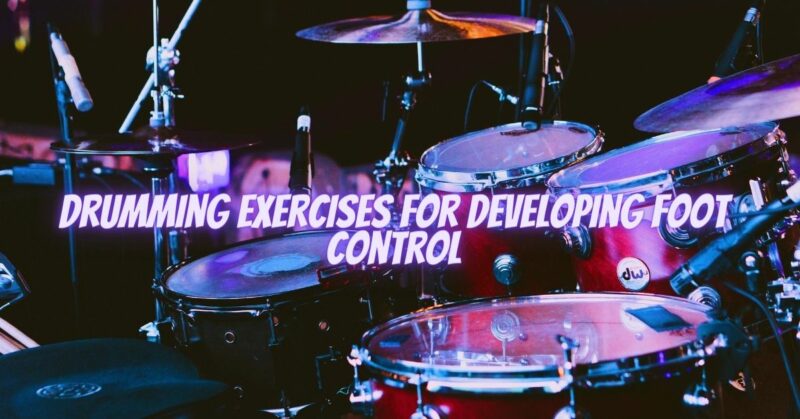Developing foot control is crucial for drummers seeking to enhance their overall drumming technique, speed, and versatility. Strong foot control allows for precision and control when playing bass drum patterns, double bass pedal techniques, and complex rhythms involving footwork. In this article, we will explore effective drumming exercises specifically designed to improve foot control and develop the dexterity and coordination required for intricate footwork.
- Single Pedal Technique: a. Heel-Toe Technique: Begin by practicing the heel-toe technique, which involves using both the heel and toe to generate two distinct sounds. Start with the ball of your foot resting on the pedal. Push down with your heel to produce the initial stroke, followed by a controlled release and a rebound from the ball of your foot to produce the second stroke. Practice this technique slowly, gradually increasing speed and ensuring consistent volume and timing between the two strokes. b. Sliding Technique: Practice the sliding technique, where you use the ball of your foot to slide smoothly between the two strokes without lifting your foot off the pedal. Focus on maintaining a consistent and controlled motion while maintaining a steady tempo.
- Double Bass Pedal Techniques: a. Isolated Footwork: Practice exercises that isolate each foot when using a double bass pedal. Start with simple exercises such as alternating single strokes between your feet, gradually increasing speed and incorporating different rhythmic patterns. This helps develop coordination and independence between your feet. b. Unison Exercises: Incorporate unison exercises that involve both feet playing the same rhythm or pattern simultaneously. Start with slow tempos and gradually increase the speed while maintaining accuracy and control. This helps develop synchronization and balance between your feet.
- Rhythmic Patterns: a. Four-on-the-Floor: Focus on playing consistent quarter-note patterns with your bass drum foot, commonly known as “four-on-the-floor.” Start with a slow tempo and gradually increase the speed while maintaining a steady rhythm and control. b. Syncopated Patterns: Practice playing syncopated rhythms with your foot, incorporating off-beat accents, ghost notes, and variations in timing. This helps develop dynamic control and adds complexity to your footwork.
- Independence Exercises: a. Hand-Foot Coordination: Work on exercises that involve coordination between your hands and feet. Play different rhythms or patterns with each limb, combining bass drum patterns with snare drum or cymbal patterns. Start slowly and gradually increase the complexity and speed of the exercises. b. Polyrhythmic Exercises: Practice exercises that involve playing contrasting rhythms with your hands and feet simultaneously. For example, play a triplet pattern with your foot while playing a different rhythm with your hands. This develops coordination, independence, and the ability to play complex rhythms.
- Tempo Control: a. Metronome Practice: Use a metronome to practice various exercises, focusing on maintaining a steady tempo. Start at a comfortable tempo and gradually increase the speed as you progress. This helps develop control, precision, and accuracy in your footwork. b. Subdivision Practice: Practice playing foot patterns at different subdivisions of the beat, such as eighth notes, triplets, or sixteenth notes. This improves your ability to maintain consistent timing and control at varying tempos.
- Dynamic Control: a. Dynamic Exercises: Practice playing bass drum patterns with varying dynamics, from soft to loud. Focus on controlling the volume and articulation of each stroke, emphasizing the accents and ghost notes within the patterns. This develops control and adds musicality to your footwork.
- Endurance Training: a. Repetitive Patterns: Practice playing repetitive bass drum patterns for an extended period, gradually increasing the duration of the exercise. This builds endurance and strengthens the muscles in your foot. b. Double Bass Pedal Endurance: If using a double bass pedal, incorporate exercises specifically designed to improve endurance and stamina, such as playing fast double bass patterns for an extended duration.
Conclusion: Developing foot control is a gradual process that requires consistent practice and focused exercises. By incorporating these drumming exercises for foot control, you can improve your overall drumming technique, speed, and versatility. Remember to start slowly, maintain good technique, and gradually increase the difficulty as you progress. Consistency, patience, and a dedicated practice routine will lead to significant improvements in your foot control, allowing you to execute complex footwork with precision and confidence. With time and practice, you will unlock new possibilities for creativity and musical expression behind the drum kit.

